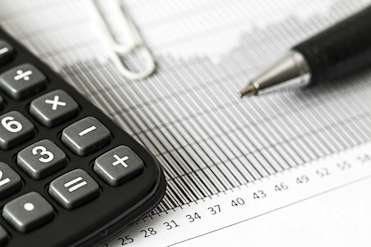
Tax and pensions
Claiming back VAT in 3 steps
Simple, smart accounting software - no commitment, cancel anytime

An invoice is used to collect payment after delivering goods and services. A receipt serves as proof of payment after a customer pays for a good or service.
As a business owner, you’ve probably used invoices and receipts before. They both keep a record of sales so you can track every transaction within your business and organise your payments. But are they the same thing?
While these documents have some similarities, they’re used for different purposes. This quick guide will help answer your questions about the differences between invoices and receipts so you can use them appropriately within your business.
An invoice is used when a business has fulfilled a customer’s order and needs to collect payment for the goods or services provided. As a business owner, you would send an invoice to notify a customer that payment is due.
Many service providers use invoices for B2B transactions, consulting services, and property management. They look similar to a bill, and list the services and goods you provided.
For example, if you own a construction company and renovated a customer’s garage, you’ll likely send them an invoice before they pay. You’ll list the services provided, the required materials, and the payment amount.
Invoices include detailed information about the goods and services you provided.
Here’s how to write an invoice:
Add your business name, contact information, and logo.
Write down the customer’s name and contact information.
Include the invoice number and date you created it, as well as the date of service.
Describe the goods or services provided, including price and quantity.
Spell out the payment information, including payment due dates, total amount, and acceptable forms of payment.
You can also add a message to the customer at the bottom of the invoice. Some platforms such as QuickBooks allow you to automatically generate invoices to save on admin time.
Using an invoice template will help you save time and ensure you include all the important details.
A receipt is used as proof of payment when a customer makes a payment to a business for goods or services. The business should provide a receipt after the payment is made to serve as a record of the sale. Receipts are also important supporting documents for tax season as they support the entries in your books and tax return.
Receipts outline when a transaction took place, how much the customer paid, the payment method used, alongside the items or services the customer paid for. Receipts help both you and the customer keep track of completed payments.
Since receipts indicate proof of purchase, businesses can use them to verify a transaction in case there’s a problem with the purchase and it needs to be refunded.
Businesses of all types use receipts and generally issue them for any completed payments. For example, after the customer pays the invoice issued for the garage renovation, you’ll then give them a receipt listing the payment information.
There are different types of receipts, from cash register receipts to email receipts. Here’s what they should all include:
Add your business name and contact information.
Include the transaction number or order number.
List the goods or services provided, including price and quantity.
Note the total amount paid, including taxes, fees, and discounts.
Some receipts will also include the customer’s contact information and payment method, as well as the return policy. Fortunately, you might not need to worry about creating a receipt as many payment tools automatically generate receipts when a customer makes a payment.
While invoices and receipts have some similarities, they’re used at different stages of the sales process and track different information. The main differences are:
When they’re issued: Invoices are issued before a business has received payment from a customer, and a receipt is issued after payment has been collected.
Payment information they contain: Invoices contain information about a future payment, including how to pay for it and when it is due. Receipts contain information about a completed payment, including the date and amount paid.
How they’re used in accounting: Receipts record a completed sale, so you’ll record them as income. Invoices mean the customer still has to pay you, so you’ll record them as accounts receivable.
Keeping track of your payments is perhaps one of the most vital aspects of running a business. You’ll need to keep record of payments in order to understand your own cash flow, and stay on top of your running costs. Both receipts and invoices are also essential for VAT purposes. A VAT registered business must issue a VAT invoice for each sale, and have a valid VAT receipt for each purchase in order to reclaim VAT.
Invoices and receipts are both designed to do this. Invoices state exactly how much you are owed, and receipts state how much you have been paid.
Knowing the differences and similarities of an invoice vs. a receipt will help you use them accurately within your business. Keeping track of invoices is an important part of getting paid on time and keeping your books clean. Using specialised invoicing software to organise these tasks can streamline your processes and give you more time to focus on your business.
QuickBooks can help you create invoices and sales receipts, so you can simplify getting paid and keep track of your business finances in one place. Learn more about how QuickBooks can help you here.
Still have questions about invoices and receipts? We’ve got the answers.
If you’re not VAT registered, you don’t have to provide an invoice and a receipt with every transaction. For example, if your customers will be paying as soon as they receive the goods or services, you’ll only need to give them a receipt. If you are VAT registered you need to issue a VAT invoice for each sale.
An invoice does not indicate that a business has been paid for goods or services provided to its customers. An invoice is created to notify the customer that they will need to pay for the good or service they received.
Businesses should not use invoices and receipts interchangeably. You should use invoices to inform a customer that a payment is due and receipts as proof of payment.
Invoices should be issued before a customer has made a payment. In some cases, businesses may need to issue specific types of invoices after a customer has paid; these are called credit invoices and debit invoices.
Credit invoices are used when you need to issue a refund to a client, and debit invoices are used to collect payment when you need to increase the amount a client owes your business.
Invoice payment terms are agreements between the customer and the business that state when a payment is due and which goods or services were provided. It’s important to specify when a payment is due and which payment options your customers have to help avoid late payments.
This content is for information purposes only and should not be considered legal, accounting or tax advice, or a substitute for obtaining professional advice specific to your business. Additional information and exceptions may apply. Applicable laws may vary by region, state or locality. No assurance is given that the information is comprehensive in its coverage or that it is suitable in dealing with a customer’s particular situation. Intuit does not have any responsibility for updating or revising any information presented herein. Accordingly, the information provided should not be relied upon as a substitute for independent research. Intuit does not warrant that the material contained herein will continue to be accurate nor that it is completely free of errors when published. Readers should verify statements before relying on them.
We may occasionally provide third-party links as a convenience and for informational purposes only. Intuit does not endorse or approve the views or opinions of any corporation or organisation or individual herein. Intuit accepts no responsibility for the accuracy, or legality, of third-party content.
Subscribe to get our latest insights, promotions, and product releases straight to your inbox.
9.00am - 5.30pm Monday - Thursday
9.00am - 4.30pm Friday